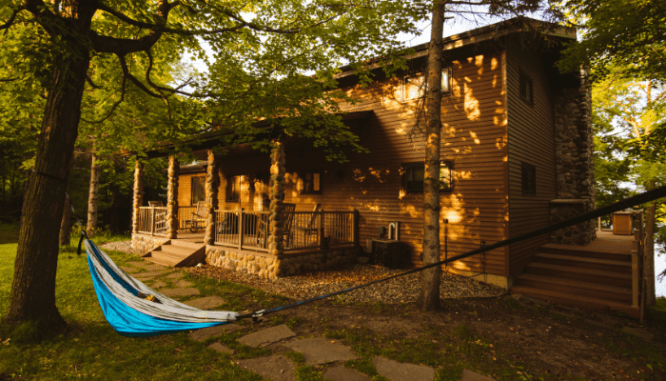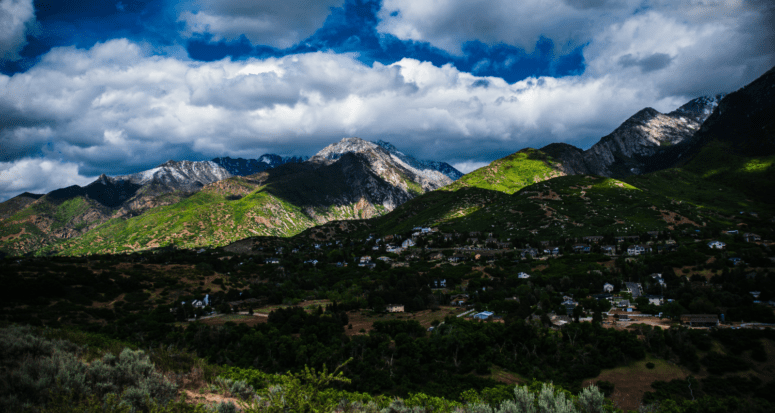Navigating the Slopes and Market in The New Silicon Valley: How to Buy a House in Salt Lake City
- Published on
- 7 min read
-
 Eileen Wubbe Contributing AuthorClose
Eileen Wubbe Contributing AuthorClose Eileen Wubbe Contributing Author
Eileen Wubbe Contributing AuthorEileen Wubbe is a New York-based writer and editor covering finance and real estate.
Envision yourself at the top of a mountain looking down into a valley of opportunity. If you’re looking to live in a metropolitan area that offers an abundance of diverse cultural options and easy access to nature, Salt Lake City is your perfect fit. Whether you want to hit the slopes (there are 11 ski resorts within 60 minutes of Salt Lake City), hike along trails in the nearby Wasatch Mountains, swim in the Great Salt Lake or stroll through the trendy Sugar House neighborhood, there is something unique for everyone in Salt Lake City.
The city’s outdoor offerings, diverse neighborhoods, lower unemployment levels, and attractive property tax rates have spurred exponential growth in recent years, and real estate is at a premium. Tech and healthcare industries are booming here, making the city an attractive option for millennials.
Buying a house here will take some savvy to overcome the ultra-competitive environment. With homes in the early months of 2021 typically getting 20 offers within two or three days, be prepared to go over the asking price on your bid and ask for minimal concessions. COVID-19 has contributed to this competitive trend, as people are less willing to move out during the pandemic and more are moving in.
So we talked to top real estate experts throughout Salt Lake City, and explored neighborhoods in and around the valley to bring you the best recommendations for your budget and lifestyle. We also interviewed home remodeling and inspection specialists to help you avoid common pitfalls so you can learn how to navigate the market and buy a house in Salt Lake City.
Lace up your hiking boots and let’s get going!

Get the lay of the land in Salt Lake City
Salt Lake City is in Salt Lake County, in a valley bordered by picturesque mountains on all four sides. The city is laid out using a grid system and areas are described in relation to Salt Lake Temple, which is considered to be the center of town. If you want to fit in with the locals, you’ll know that “in the valley” means Salt Lake City proper, while “outside the valley” refers to towns and neighborhoods outside of the city.
Salt Lake City proper, which includes Downtown, Central City, Sugar House, Avenues, University/Foothill, and Granary/Ballpark, is full of cultural opportunities, great restaurants and bars, and easy access to public transportation. Plus, you can get around downtown easily — and for free — with UTA’s Free Fare Zone.
Outdoor recreation
With so many outdoor activities to choose from in and around SLC, you can embark on an adventure any time of year.
Salt Lake City is known as Ski City for a reason. It’s home to famous resorts like Brighton and Alta, with a slew of slopes just a short drive away. Whether you’re a seasoned pro or a novice, or prefer snowboarding or snowshoeing, there’s plenty to explore.
If you’d rather hit the hiking trails, check out the Bonneville Short Trail. Now a popular spot for biking and hiking, this trail used to be the shoreline of a prehistoric lake, Lake Bonneville. Millcreek Canyon, a canyon in the Wasatch Mountains, is easily accessible with several hiking trails, including Donut Falls and Dog Lake. Donut Falls is an easy hike for adults and kids alike, while Dog Lake is a moderate-to-difficult hike that takes you through an alpine forest leading to the lake in a meadow.
SLC has anglers covered with an abundance of fantastic fishing spots. And if you’re a birdwatcher, you’re in luck because Salt Lake City is on the north/south migration routes for many birds. You’ll also want to mark your calendar for the Great Salt Lake Bird Festival.
Festivals
Salt Lake City is home to several well-known festivals, although as of February 2021, cultural events have been scaled back or gone virtual due to the COVID-19 pandemic. The Sundance Film Festival, which has expanded from nearby Park City, Utah, runs for two weeks each winter. Celebrities and locals hobnob throughout the city at six theaters to watch films and attend panels and parties. Salt Lake City also hosts the three-day outdoor multidisciplinary Utah Arts Festival, which typically draws 70,000 attendees and features artists from around the world each June. Here you can catch anything from live graffiti paintings to the Salt Lake City Orchestra to cowboy poets reciting prose, often paying homage to the Western lifestyle.
Sports
If sports are more your thing, you can take on Utah Jazz games downtown at the Vivint Smart Home Arena. Soccer fans can cheer on MLS teams Real Salt Lake and Utah Royals FC at the Rio Tinto Stadium in Sandy, and Salt Lake City is also home to The Utah Warriors professional rugby team.
Art
For art, there is no shortage of galleries and museums across Salt Lake City, from the Utah Museum of Fine Art to the Urban Arts Gallery and the Utah Museum of Contemporary Art, both of which are free.
Neighborhoods
Some of the most desirable downtown neighborhoods are The Avenues, Capitol Hill, and bike-friendly Central City. Capitol Hill is home to the Salt Lake Acting Company and easy access to City Creek Canyon. The Avenues is Salt Lake City’s largest historic district, with 100 square blocks of late 19th and early 20th century architecture in a variety of styles. According to the Greater Avenues Community Council, more than 100 architect-designed homes have been identified in the Avenues Historic District. This is the type of neighborhood you won’t mind getting lost in. After exploring, refuel at Avenues Proper, a nearby Gastropub with an on-site brewery, serving local Utah beer.
Sugar House, named after the sugar beets first planted here more than 150 years ago, is perhaps one of the most sought-after and hippest neighborhoods in Salt Lake City proper, with great restaurants, bars, shopping and Sugar House Park. Pet friendly Campfire Lounge has outdoor fire pits and campfire-esque favorites on the menu like “The Big Bubba.” For a fancy meal out, Table X Restaurant, a few miles away in Mill Creek, won’t disappoint. Housed in a former abandoned cheese factory, it features locally sourced food taken from its very own culinary garden outside.

The new Silicon Valley
Utah has seen a population growth of 16% over the last decade, according to the U.S. Census Bureau. “They’re coming in droves,” says top-rated real estate agent Jay Bentley, a Salt Lake City-based single-family home expert who works with over 73% more single-family homes than the average Salt Lake City agent. Bentley says about a third of transplants who buy a house in Salt Lake City are coming from out of state, particularly from California.
Tech
With more than 6,500 startup and tech companies in Utah, the area’s booming tech industry is adding to Utah’s appeal. In fact, Salt Lake City is commonly referred to as the New Silicon Valley, with 1 in 7 employed in the tech industry. If you work in tech, you’re likely to live in the south end of the valley. This area meets the north end of Utah Valley and the combined area is referred to as “Silicon Slopes,” due to all of the tech companies in the area (Overstock.com, Ancestry.com, Artemis Health, Adobe Inc. have a presence here, just to name a few). Additionally, the south end of the valley has land available for residential development so you’ll find modern homes with more square footage and larger lot sizes that aren’t available in downtown or center of the valley.
Higher education and healthcare
Higher education and healthcare round out other popular industries. The University of Utah, Westminster College, Western Governors University, Salt Lake Community College, Brigham Young University, and Utah Valley University, the biggest school in the state are located in Salt Lake City or nearby towns. According to the Salt Lake City Economic Development, the largest sector in Salt Lake City is Health Care and Social Assistance, employing 34,483 workers.
Millennial appeal
Millennials make up 32% of Salt Lake City residents, and generally fall into two groups. The first is drawn downtown for the amenities, night scene and the dominant demographics for that area. The second is less drawn to nightlife, wants to have larger families, and owns RVs and boats so they need a bigger house and property to accommodate. The southwest part of the valley is more accommodating and more affordable than the downtown area, and those looking for more space will opt to house hunt in the surrounding MidValley area, including Cottonville Heights, Midvale and Holladay, and South Valley, including Sandy and Draper.
The National Association of Realtors® (NAR) named Salt Lake City as one of the 10 markets with favorable conditions for millennial homebuyers during the coronavirus pandemic. NAR identified the markets based on housing affordability, local job market conditions during the coronavirus pandemic, the share of millennials in the area, and inventory availability in the largest 100 metropolitan statistical areas across the country. The 10 markets listed had a smaller number of workers in industries most affected by the 2020 pandemic-induced economic lockdown, and a high percentage of millennials residing in the area.
What can you get for your money in Salt Lake City
For those looking to buy a house in Salt Lake City proper, you’ll be up against a lot of competition as they are increasingly harder to come by. You can expect to pay around $300 a square foot for a two-bedroom, one-bath house on a .11 acre lot, according to Bentley. If you look outside Salt Lake City proper, you can get significantly more home and yard space — about $170 a square foot for a three- or four-bedroom home with three bathrooms, a two-car garage and more property.
The median price of a home in the U.S. was $324,900 as of October 2020, making Salt Lake City’s booming housing market expensive in comparison.
The average home sales price for new and existing homes in the Salt Lake City Comprehensive Housing Market Analysis was $396,100 during the 12 months ending June 2020, up 8% from the previous 12-month period.
One area Salt Lake City has most of the country beat is with property taxes. Salt Lake City’s general property tax rate is .015288%. To put this low tax rate in perspective, New Jersey has the highest effective rate on owner-occupied property at 2.21%, followed closely by Illinois at 2.05%, according to the Tax Foundation.

Salt Lake City’s home styles and housing stock
New homes are in huge demand in SLC and the supply is low, but construction is booming and more houses are hitting the market. There is a home for every taste and budget if you look closely enough.
To give you an idea of the home styles in Salt Lake City, we’ve compiled a list of the most popular homes you’ll see in and around the valley. According to Preservation Utah, Utah’s home styles are primarily from six different time periods.
Pioneer
Encompassing homes from 1847 to 1890, the Pioneer Period features Federal, Georgian, and Greek Revival styles of homes. Pioneer-style homes have a stretched-out feel, with one side rectangular and the other short. These homes are typically made of brick, stone or adobe with wood frames.
Victorian
Often featuring towers or turrets facing upward, Victorian-era homes are described as more whimsical, with many curves and angles. You’ll find historic homes and mostly older Victorian-era homes in The Avenues.
Early 20th Century Period
Bungalow, Arts and Crafts, and Prairie School are the most common home styles from this time period. Bungalows are known for their big front porches and are popular for friends and neighbors to gather outside.
“Salt Lake City is very social and people tend to know each other and what’s going on in the neighborhood and look out for each other,” Bentley says. “Friends will come over and sit on the front porch. Bungalows create opportunities to socialize.”
Period Revival Period (1910-1955)
Common styles include the Colonial Revival, Tudor Revival Cottage, English Tudor, and Neoclassical styles.
Bentley notes his penchant for the Tudor style in Salt Lake City proper: “I really like the red brick and steep roofline over the top of the door. They are a very appealing home, but kind of tough to come by.”
Early Modern Period (1930-1955)
International, Art Moderne, and Art Deco styles represent this period. Should you come across one of these less-common styles in Salt Lake City, you’ll often find that they are surrounded by more traditional-style houses. The facade of these homes is often asymmetrical and borrows the look of machined surfaces and used machine-finished industrial products.
Post-War Modern Period (1949-1970)
Homes from this era include Post-War Modern and ranch. These homes are more pared down and less ornamental than those of years past, reflecting the mood of a nation still recovering from the Great Depression. That translated to smaller and simpler styles. The facade is usually asymmetrical, and there is often a gable facing the street.

Navigating common repairs in Salt Lake City: Tips for buyers
With Salt Lake City now in its second housing boom, and a wide array of house styles from different periods, we’ve drilled down some issues common with homes in this area so you know potential issues .
Why a good home inspection is so important
Home inspections are always a good idea, and they’re an especially good idea in Salt Lake City, where dangerous electrical plates, settling or cracking foundations, and sloping floors can create serious headaches for homeowners. In Utah, there aren’t any licensing or qualifications required to be a home inspector, so you’ll want to make sure you find an inspector who is nationally certified to help identify any potential problems.
Beau Brown, a certified home inspector with C&H Inspections in Magna, Utah, says the most common electric panels put in during Salt Lake City’s housing boom in the 1960s-1990s were Zinsko and Federal Pacific, both known for starting fires. “Finding these in a house is a big deal,” he says. “Oftentimes houses can’t be insured if they have these panels.”
Brown notes that in the age of COVID-19, some people are removing the due diligence period and will buy a house as is, without an inspection. While this might make an offer more appealing to a seller, there’s a big downside. Even if you waive the inspection contingency in your offer, you should still get an inspection before closing to ensure that you understand what issues the house might have.
“I’m going to crawl back into the dark, spider webbed corners of your crawl space and find the plumbing leak that’s been there for 25 years, slowly eroding away at one of the foundational piers,” Brown says.
“Inspections are about knowing what you own and what’s wrong so you can turn it into a honey-do list and get it fixed down the road when you have the money for it.”
Plumbing
Scott Starley, CEO of Progressive Remodelers, Inc. cautions that galvanized water lines are a common problem with older homes in Salt Lake City, and may require plumbing upgrades to install new, flexible PEX water lines. “Main drain lines have also been an issue, particularly in older homes where the cast iron can be 60 to 70 years old, and cracking and leaking,” he says.
These issues are common in homes 40 years and older. Galvanized pipe tends to build up with debris inside the walls, which eventually restricts the flow of water through those pipes, affecting the water pressure.
Concessions in a home contract
Traditionally, when you buy a house in Salt Lake City, it’s been common for sellers to pay the cost for buyers to get a loan and the appraisal fee. But as the housing market in Salt Lake City heated up in 2020 that changed.
With few homes on the market and even fewer being listed each week, Bentley says in order for an offer to stand any chance of being accepted, the buyer must offer 1% of the purchase price for earnest money, and, in many cases, make the offer not contingent on the appraisal, and have the ability to make up the difference between purchase price and appraised value.
“In the last nine months it’s impossible to get money from the seller so the only concession second to that would be to make the purchase subject to selling another residence,” Bentley says. “It makes it pretty tough to do, so you have to get creative in the way you line the two up to fall. If you do it right, you can still be competitive and win bids. But you have to have your ducks in a row and be properly prepared prior to making the offer.”
Why use a top agent to buy a house in Salt Lake City?
The most popular time to buy a house in Salt Lake City is between March and June, but you’ll likely get the best deal if you buy a house in Salt Lake City in January. With a highly competitive market, having a good agent in your corner is critical to working quickly on negotiations and successfully getting to the closing table. The top buyer’s agents in SLC help buyers purchase 1.8 times more homes, and save them $32,737, compared to the average agent.
If you’re ready to explore the great outdoors and make SLC your next home, connect with a buyer’s agent to help you beat out the competition, and call those mountain views your own.
Header Image Source: (Jake Green / Unsplash)

